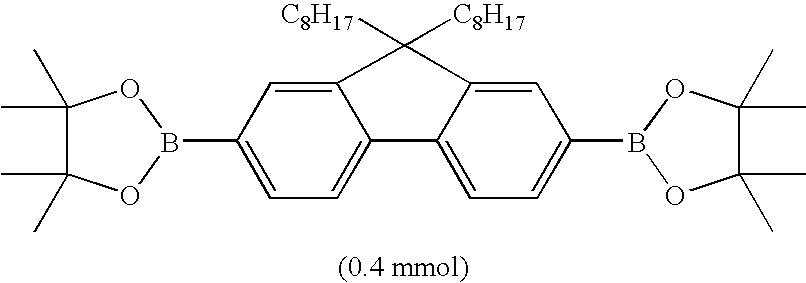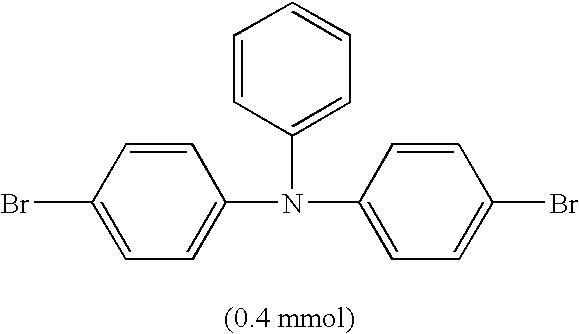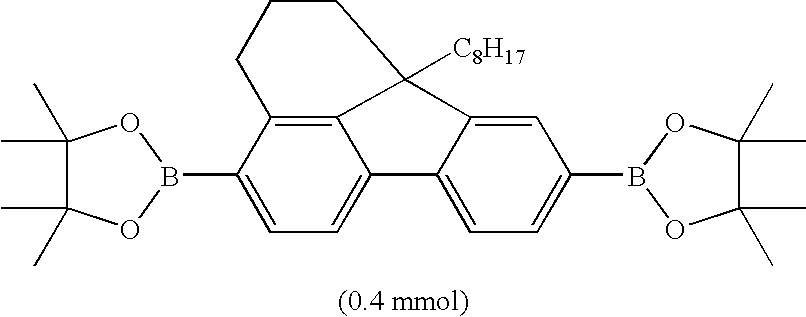Purification process for organic electronics material
a technology of organic electronics and purification process, which is applied in the direction of discharge tube luminescence screen, separation process, liquid cleaning, etc., can solve the problems of easy degradation of luminescence efficiency, low efficiency, and low stability, and achieve the effect of effective removal
- Summary
- Abstract
- Description
- Claims
- Application Information
AI Technical Summary
Problems solved by technology
Method used
Image
Examples
examples
[0040] The present invention is explained further in detail below with reference to Examples, but the present invention is not limited by the Examples below.
synthetic examples 1 and 2
Synthesis of Polymer
[0041] A reaction was carried out using a dedicated polytetrafluoroethylene reaction vessel. With regard to a solvent, oxygen in the solvent was removed using nitrogen gas for 30 minutes or longer before use. The reaction vessel was charged with monomers shown in Table 1 and further, in a glove box under an atmosphere of nitrogen, with a 3 vol % anisole solution (8 ml) of tricaprylmethylammonium chloride and an 8 mM anisole solution (100 μL) of Pd(PPh3)4. After the monomers were dissolved by stirring, a 2M aqueous solution (5.3 ml) of K2CO3 was added. The reaction vessel was set in a microwave reaction device, and a Suzuki coupling reaction was carried out while stirring under microwave irradiation with conditions shown in Table 2. As a reference for controlling the temperature, a mixture of all the reagents and solvents other than the monomers was used. After the reaction was completed, the reaction mixture was poured into methanol-water (ratio by volume (the sa...
examples 1 and 2
Purification of Polymer
[0046] The polymer obtained in Synthetic Examples 1 and 2 was dissolved in toluene (10 ml relative to 100 mg of polymer), triphenylphosphine, polymer-bound on styrene-divinylbenzene copolymer (200 mg relative to 100 mg of polymer, 15-6730, manufactured by STREM Chemicals Inc.) was added, and stirring was carried out overnight. After stirring was completed, the triphenylphosphine, polymer-bound on styrene-divinylbenzene copolymer was removed by filtration, and the filtrate was concentrated using a rotary evaporator. The residue was dissolved in toluene, and then reprecipitated from methanol-acetone (8:3). The precipitate thus formed was filtered by suction and washed with methanol-acetone (8:3). The precipitate thus obtained was dried in vacuum to give a polymer. The polymer thus obtained was subjected to ICP emission analysis, and the results are given in Table 4.
TABLE 4Crude polymerproductPd content (ppm)Example 3Synthetic Example 1Example 4Synthetic Exam...
PUM
| Property | Measurement | Unit |
|---|---|---|
| temperature | aaaaa | aaaaa |
| temperature | aaaaa | aaaaa |
| temperature | aaaaa | aaaaa |
Abstract
Description
Claims
Application Information
 Login to View More
Login to View More - R&D
- Intellectual Property
- Life Sciences
- Materials
- Tech Scout
- Unparalleled Data Quality
- Higher Quality Content
- 60% Fewer Hallucinations
Browse by: Latest US Patents, China's latest patents, Technical Efficacy Thesaurus, Application Domain, Technology Topic, Popular Technical Reports.
© 2025 PatSnap. All rights reserved.Legal|Privacy policy|Modern Slavery Act Transparency Statement|Sitemap|About US| Contact US: help@patsnap.com



